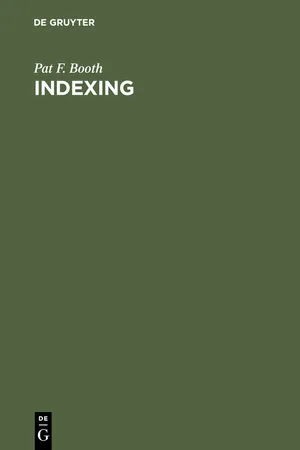
- 503 pages
- English
- PDF
- Available on iOS & Android
eBook - PDF
About this book
No detailed description available for "Indexing".
Frequently asked questions
Yes, you can cancel anytime from the Subscription tab in your account settings on the Perlego website. Your subscription will stay active until the end of your current billing period. Learn how to cancel your subscription.
At the moment all of our mobile-responsive ePub books are available to download via the app. Most of our PDFs are also available to download and we're working on making the final remaining ones downloadable now. Learn more here.
Perlego offers two plans: Essential and Complete
- Essential is ideal for learners and professionals who enjoy exploring a wide range of subjects. Access the Essential Library with 800,000+ trusted titles and best-sellers across business, personal growth, and the humanities. Includes unlimited reading time and Standard Read Aloud voice.
- Complete: Perfect for advanced learners and researchers needing full, unrestricted access. Unlock 1.4M+ books across hundreds of subjects, including academic and specialized titles. The Complete Plan also includes advanced features like Premium Read Aloud and Research Assistant.
We are an online textbook subscription service, where you can get access to an entire online library for less than the price of a single book per month. With over 1 million books across 1000+ topics, we’ve got you covered! Learn more here.
Look out for the read-aloud symbol on your next book to see if you can listen to it. The read-aloud tool reads text aloud for you, highlighting the text as it is being read. You can pause it, speed it up and slow it down. Learn more here.
Yes! You can use the Perlego app on both iOS or Android devices to read anytime, anywhere — even offline. Perfect for commutes or when you’re on the go.
Please note we cannot support devices running on iOS 13 and Android 7 or earlier. Learn more about using the app.
Please note we cannot support devices running on iOS 13 and Android 7 or earlier. Learn more about using the app.
Yes, you can access Indexing by Pat F. Booth in PDF and/or ePUB format, as well as other popular books in Languages & Linguistics & Library & Information Science. We have over one million books available in our catalogue for you to explore.
Information
Edition
1Subtopic
Library & Information ScienceTable of contents
- The author
- Society of Indexers’ Foreword
- Preface
- CHAPTER ONE. INDEXES – PURPOSE AND USES
- Myths about Indexes
- Myths about Indexing
- Introduction to Indexes and Indexing
- Applications of Indexing
- ‘The Good Index’: What Characterizes It
- The Thrills and Spills of Indexing
- References
- CHAPTER TWO. INDEXERS
- Indexers – Who Are They?
- Professional Knowledge
- General Knowledge
- Special Subject Knowledge
- Neutrality of the Indexer
- The Indexer’s Reference Sources
- ‘How They Index’
- Who Should Not Be an Indexer?
- References
- CHAPTER THREE. WHAT (AND WHETHER) TO INDEX
- The Indexer’s Focus
- Indexable Parts of Documents (Which to Index, Which to Ignore)
- Indexable Content
- ‘Sensitive’ Content
- Revisions of Indexes
- Index Density (Depth of Indexing)
- References
- CHAPTER FOUR. FORMING THE INDEX ENTRIES
- Putting Ideas into Words – the Headings
- Indicating the Position – the Locators
- Cross-References
- Preparation for Editing
- References
- CHAPTER FIVE. EDITING AND PRESENTING THE INDEX
- The Need for Editing and Presentation
- What May Need to be Done
- Alphabetical Arrangement
- Presentation and Layout
- References
- CHAPTER SIX. SERIAL PUBLICATIONS
- Working with Serials
- What is a Serial Publication?
- Serial Types and Their Characteristics
- Why is Indexing a Serial Any Different from Indexing a Book?
- Working Arrangements
- References
- CHAPTER SEVEN. IMAGES AND SOUND (AUDIO) RECORDINGS
- Indexability and Indexing Needs
- Images – Categorization and Features
- Sound Materials – Categorization and Features
- References
- CHAPTER EIGHT. SUBJECT SPECIALISMS
- ‘Generality and Speciality’
- Readership
- Indexable Content
- Number of Sequences
- Form and Detail of Entries
- Specialist Areas
- Law
- References
- Medicine
- References
- Archaeology
- References
- Genealogy and Family History
- Science and Technology
- References
- Biography
- References
- CHAPTER NINE. LITERATURE FOR CHILDREN
- Index Awareness
- Documentary Forms
- The Indexing Needs and Information Skills of Children
- Characteristics of Indexes for Children
- Fiction Indexing
- The Nature and Value of the Work
- References
- CHAPTER TEN. MANAGING THE WORK
- Employment Status
- The Home Office
- Sources of Information
- Finding Freelance Work
- Financial Aspects of Freelancing
- Ways of Working
- Client Relations
- Ethics and Professional Responsibilities
- References
- CHAPTER ELEVEN. TECHNOLOGY
- Document Technology
- Indexing Technology (Input and Output)
- Software
- Troubleshooting and Support
- References
- Dedicated Indexing Software: Producers
- CHAPTER TWELVE. PROFESSIONAL ORGANIZATIONS AND INTEREST GROUPS
- Professionalism in Indexing
- People and Groups
- Indexing Societies
- Internet Discussion Groups and Mailing Lists
- Related Organizations in the UK
- INDEX